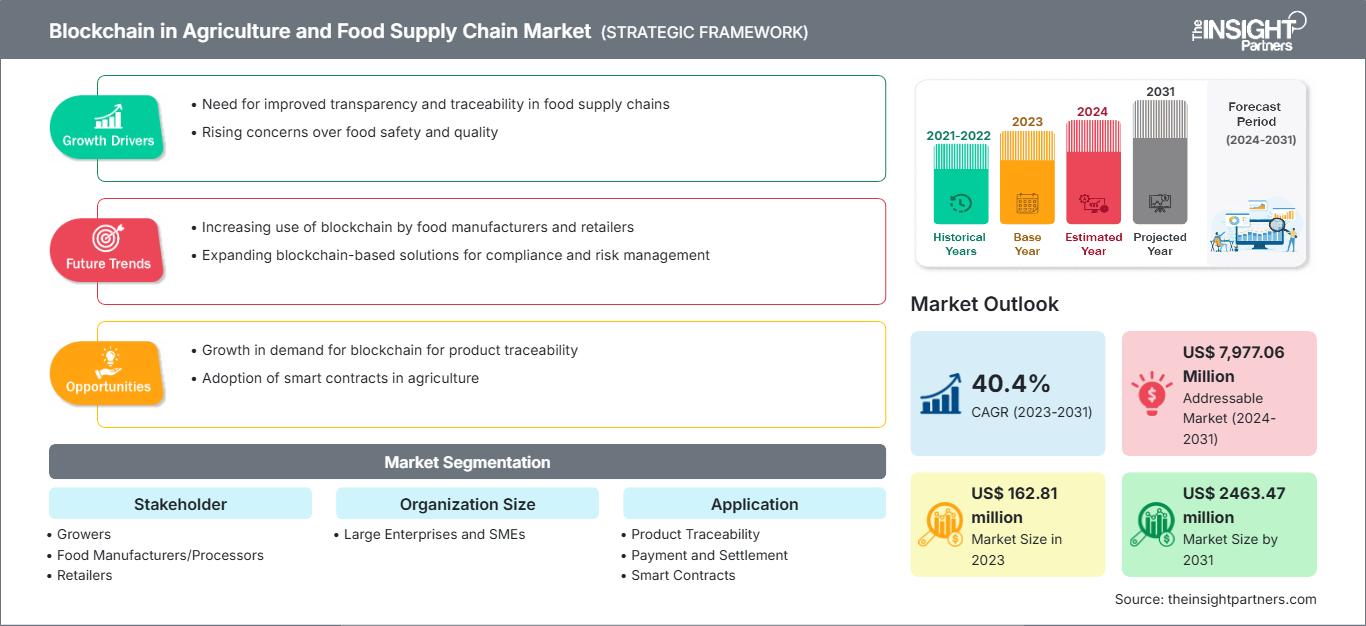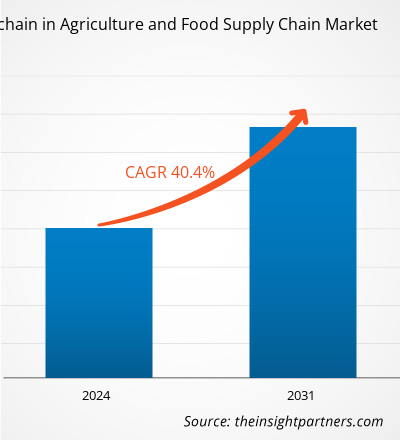농업 및 식품 공급망 블록체인 시장 규모는 2023년 1억 6,281만 달러에서 2031년 24억 6,347만 달러로 성장할 것으로 예상되며, 2023년부터 2031년까지 연평균 성장률(CAGR) 40.4%로 성장할 것으로 전망됩니다. 추적성 및 투명성 향상, 소비자의 투명성 요구, 공급망 효율성, 식품 사기 및 오염 방지, 그리고 음식물 쓰레기 감소는 농업 및 식품 공급망 블록체인 시장의 성장을 촉진하고 있습니다.
농업 및 식품 공급망 블록체인 시장 분석
중소기업의 블록체인 기술 수요 증가는 농업 및 식품 공급망 시장에서 블록체인의 입지를 강화했습니다. 또한, 사물 인터넷(IoT) 기기의 통합은 예측 기간 동안 시장 확장을 가속화할 것으로 예상됩니다. 더욱이 주요 기업들은 포트폴리오 확장과 글로벌 입지를 확대하기 위해 다양한 이니셔티브를 추진하고 있으며, 이는 농업 및 식품 공급망 시장 트렌드의 주요 블록체인으로 자리 잡았습니다.
농업 및 식품 공급망에서의 블록체인 시장 개요
- 농업 관련 기업들은 블록체인 기술에 점점 더 관심을 보이고 있습니다. 기업들은 공급망 지식이 어떻게 생성되고, 기술 개발을 통해 향상된 데이터 관리 역량을 통해 거래 병목 현상이 어떻게 해소되는지를 보여주며 점차 차별화를 꾀하고 있습니다.
- 농업 부문은 거래 비용 절감, 물류 간소화, 추적성 향상, 식품 안전 절차 개선에 있어 기술의 중요성을 강조하고 있습니다.
- 블록체인 기술은 글로벌 농업 공급망의 투명성을 개선하고, 저항을 줄이며, 거래 관련 효율성을 높일 수 있는 흥미로운 기회를 제공합니다.
요구 사항에 맞게 이 보고서를 사용자 정의하십시오.
이 보고서의 일부, 국가 수준 분석, Excel 데이터 팩을 포함하여 모든 보고서에 대한 사용자 정의를 무료로 받을 수 있을 뿐만 아니라 스타트업 및 대학을 위한 훌륭한 제안 및 할인을 이용할 수 있습니다
농업 및 식품 공급망 시장의 블록체인: 전략적 통찰력

-
이 보고서의 주요 주요 시장 동향을 확인하세요.이 무료 샘플에는 시장 동향부터 추정 및 예측에 이르기까지 데이터 분석이 포함됩니다.
농업 및 식품 공급망 시장 기회에서의 블록체인
사물 인터넷(IoT) 기기 통합으로 농업 및 식품 공급망 시장 성장에 블록체인을 활용할 수 있는 기회 창출
- 농업 및 식품 공급망에 사물 인터넷(IoT) 기기와 블록체인 기술을 통합하면 데이터 수집 및 실시간 모니터링이 개선되어 투명성, 추적성, 품질 관리가 향상되고 공급망 효율성도 높아집니다.
- 기업에서는 블록체인을 사용하여 사물 인터넷 기기의 데이터를 보호하고 있습니다. 블록체인 기술을 IoT 기기와 함께 사용하면 스마트 기기에서 확장 가능하고 안전하며 안정적인 방식으로 데이터를 교환하고 기타 금융 활동을 수행할 수 있습니다.
- 또한 IoT와 결합된 블록체인 기술을 통해 조직은 중앙 집중식 제어 및 관리가 필요 없이 데이터를 교환하고 액세스할 수 있으므로 농업 및 식품 공급망 시장에서 블록체인의 성장이 더욱 촉진됩니다.
농업 및 식품 공급망 시장 보고서 세분화 분석의 블록체인
- 조직 규모에 따라 농업 및 식품 공급망 시장의 블록체인은 대기업과 중소기업으로 세분화됩니다. 대기업 부문은 2023년에 농업 및 식품 공급망 블록체인 시장에서 상당한 점유율을 차지할 것으로 예상됩니다.
- 대기업들은 농업 및 식품 공급망을 강화하기 위해 블록체인과 같은 첨단 기술에 지속적으로 투자하고 있으며, 이는 시장 성장을 촉진하고 있습니다.
- 중소기업들 또한 가치 사슬 전반에서 곡물의 이동을 추적하고 관리하는 데 도움이 되는 블록체인 기술을 도입하기 위해 노력하고 있으며, 이는 예측 기간 동안 시장 성장을 더욱 촉진할 것입니다.
지역별 농업 및 식품 공급망 블록체인 시장 점유율 분석
농업 및 식품 공급망 블록체인 시장은 주로 북미, 유럽, 아시아 태평양, 중동 및 아프리카, 남미의 5개 지역으로 나뉩니다. 북미 지역은 빠른 성장을 경험하고 있으며 농업 및 식품 공급망 블록체인 시장에서 상당한 점유율을 차지할 것으로 예상됩니다. 북미는 다른 지역보다 훨씬 빠른 속도로 농업 및 식량 공급망 관리를 위한 현대 기술을 도입하여 가장 큰 시장 점유율을 확보했습니다. 더욱이 미국과 캐나다는 이 지역에서 가장 경제적으로 안정적인 국가로서 시장의 상당 부분을 차지하고 있습니다.
농업 및 식품 공급망 시장의 블록체인 지역별 통찰력
The Insight Partners의 분석가들은 예측 기간 동안 농업 및 식품 공급망 블록체인 시장에 영향을 미치는 지역별 동향과 요인을 면밀히 분석했습니다. 이 섹션에서는 북미, 유럽, 아시아 태평양, 중동 및 아프리카, 그리고 중남미 지역의 농업 및 식품 공급망 블록체인 시장 부문 및 지역별 현황도 살펴봅니다.
농업 및 식품 공급망 시장 보고서 범위 내 블록체인
| 보고서 속성 | 세부 |
|---|---|
| 시장 규모 2023 | US$ 162.81 million |
| 시장규모별 2031 | US$ 2463.47 million |
| 글로벌 CAGR (2023 - 2031) | 40.4% |
| 이전 데이터 | 2021-2022 |
| 예측 기간 | 2024-2031 |
| 다루는 세그먼트 |
By 이해 관계자
|
| 포함된 지역 및 국가 |
북미
|
| 시장 선도 기업 및 주요 회사 프로필 |
|
농업 및 식품 공급망 시장 참여자 밀도에서의 블록체인: 비즈니스 역학에 미치는 영향 이해
농업 및 식품 공급망 블록체인 시장은 소비자 선호도 변화, 기술 발전, 그리고 제품의 이점에 대한 인식 제고 등의 요인으로 인한 최종 사용자 수요 증가에 힘입어 빠르게 성장하고 있습니다. 수요가 증가함에 따라 기업들은 제품 및 서비스를 확장하고, 소비자 니즈를 충족하기 위한 혁신을 추진하며, 새로운 트렌드를 적극 활용하고 있으며, 이는 시장 성장을 더욱 가속화하고 있습니다.

- 을 얻으세요 농업 및 식품 공급망 시장의 블록체인 주요 주요 플레이어 개요
"농업 및 식품 공급망 블록체인 시장 분석"은 이해관계자, 조직 규모, 적용 분야 및 지역을 기준으로 수행되었습니다. 이해관계자를 기준으로 시장은 재배자, 식품 제조/가공업체, 소매업체로 세분화됩니다. 조직 규모를 기준으로 시장은 대기업과 중소기업으로 세분화됩니다. 적용 분야를 기준으로 농업 및 식품 공급망 블록체인 시장은 제품 추적성, 결제 및 정산, 스마트 계약, 거버넌스 위험 및 규정 준수 관리로 세분화됩니다. 지역을 기준으로 시장은 북미, 유럽, 아시아 태평양, 중동 및 아프리카, 남미로 세분화됩니다.
농업 및 식품 공급망 블록체인 시장 뉴스 및 최근 동향
기업들은 농업 및 식품 공급망 시장에서 블록체인을 활용하여 인수합병과 같은 무기적 및 유기적 전략을 채택하고 있습니다. 최근 주요 시장 동향은 다음과 같습니다.
- 2021년 3월, 엔터프라이즈 블록체인 플랫폼 제공업체인 BlockApps는 Amazon Web Services(AWS)와 함께 TraceHarvest 네트워크 확장을 발표했습니다. BlockApps의 TraceHarvest 블록체인 솔루션은 AWS를 활용하여 TraceHarvest의 농업 고객에게 클라우드에 대한 빠르고 유연한 액세스를 제공합니다. TraceHarvest는 블록체인을 사용하여 종자부터 농산물의 전체 수명 주기를 추적할 수 있도록 지원합니다.
[출처: BlockApps, 회사 웹사이트]
- 2020년 1월, Farmer Connect와 IBM은 "Thank My Farmer"라는 새로운 소비자 모바일 애플리케이션을 발표했습니다. 이 애플리케이션을 통해 커피 소비자는 커피의 품질과 원산지를 추적하고 원두를 재배한 농부를 지원할 수 있습니다. Farmer Connect는 IBM 블록체인 기반의 추적 플랫폼으로, 커피 공급망의 추적성, 효율성 및 공정성을 향상하도록 설계되었습니다.
[출처: IBM, 회사 웹사이트]
농업 및 식품 공급망 블록체인 시장 보고서 범위 및 결과물
농업 및 식품 공급망 블록체인 시장 전망은 주요 기업 간행물, 협회 데이터, 데이터베이스 등 다양한 2차 및 1차 연구 결과를 기반으로 추산됩니다. 시장 보고서 "농업 및 식품 공급망 블록체인 시장 규모 및 전망(2021~2031)"은 아래 영역을 포함하는 시장에 대한 상세한 분석을 제공합니다.
- 범위에 포함된 모든 주요 시장 부문에 대한 글로벌, 지역 및 국가 수준의 시장 규모 및 전망.
- 동력, 제약 및 주요 기회와 같은 시장 역학.
- 주요 미래 동향.
- 상세한 PEST 및 SWOT 분석
- 주요 시장 동향, 주요 기업, 규제 및 최근 시장 동향을 다루는 글로벌 및 지역 시장 분석입니다.
- 시장 집중도, 히트맵 분석, 주요 기업 및 최근 동향을 다루는 산업 환경 및 경쟁 분석입니다.
- 상세한 회사 프로필입니다.
- 과거 분석(2년), 기준 연도, CAGR을 포함한 예측(7년)
- PEST 및 SWOT 분석
- 시장 규모 가치/거래량 - 글로벌, 지역, 국가
- 산업 및 경쟁 환경
- Excel 데이터세트
최근 보고서
관련 보고서
사용 후기
구매 이유
- 정보에 기반한 의사 결정
- 시장 역학 이해
- 경쟁 분석
- 고객 인사이트
- 시장 예측
- 위험 완화
- 전략 기획
- 투자 타당성 분석
- 신흥 시장 파악
- 마케팅 전략 강화
- 운영 효율성 향상
- 규제 동향에 발맞춰 대응






















 무료 샘플 받기 - 농업 및 식품 공급망 시장의 블록체인
무료 샘플 받기 - 농업 및 식품 공급망 시장의 블록체인